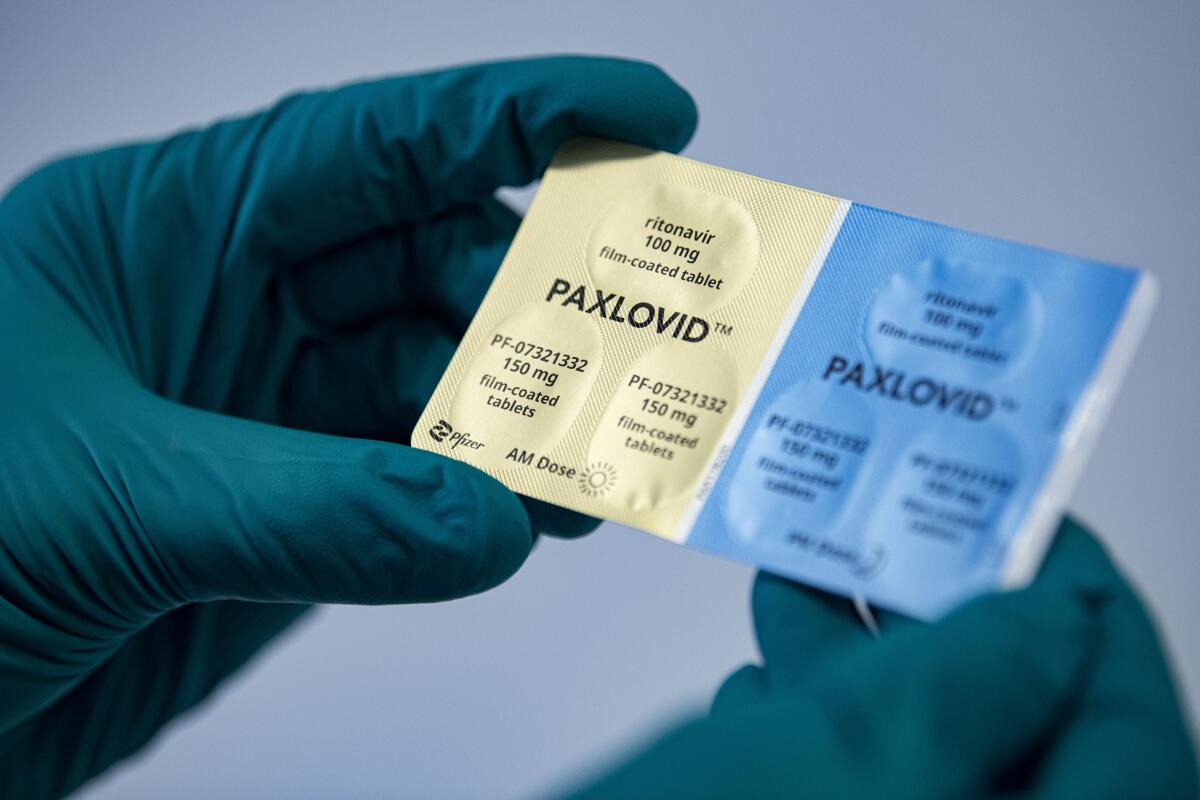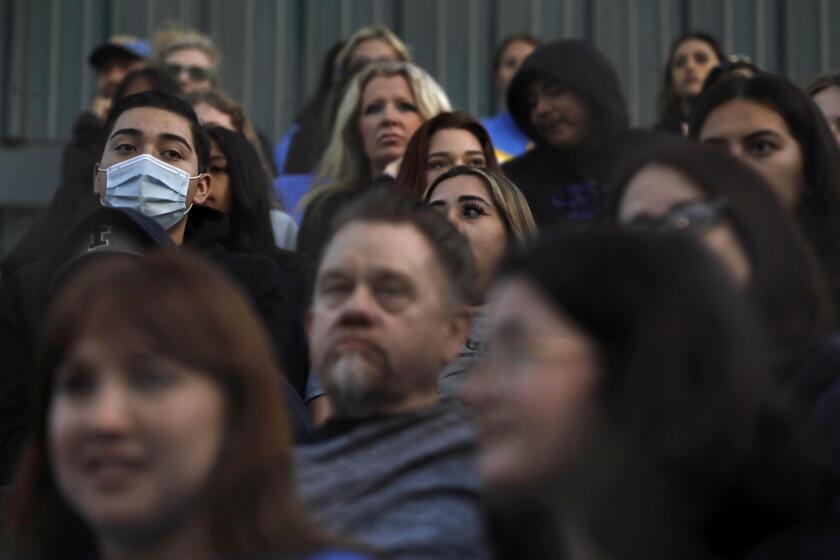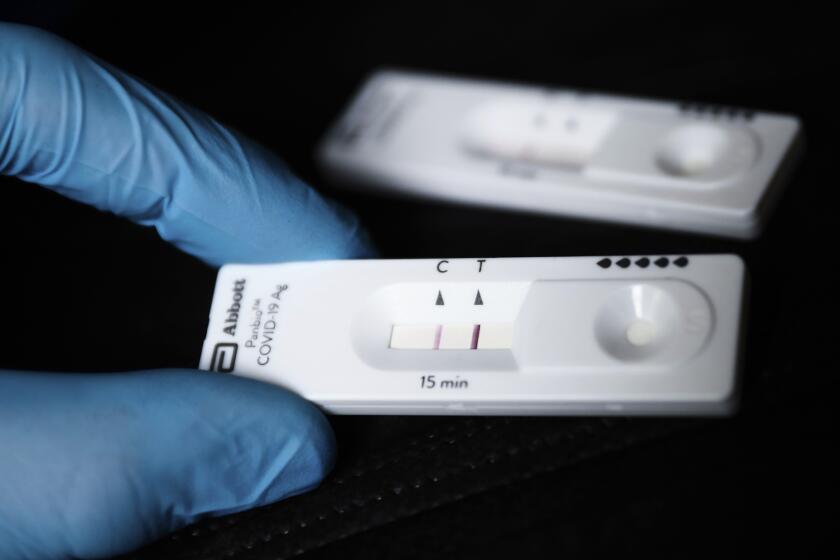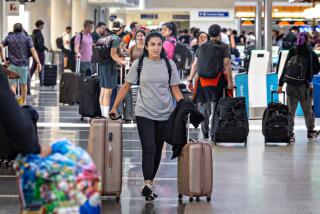New coronavirus mystery: Some are getting COVID-19 again even after taking Paxlovid

- Share via
Some coronavirus-positive patients who have completed treatment of the anti-COVID drug Paxlovid are rebounding into illness, and experts are urging people to be cautious if they develop COVID-like symptoms again and become infectious.
It’s unclear how often “post-Paxlovid rebound” occurs, but UC San Francisco Department of Medicine chair Dr. Robert Wachter said he knows of at least one person who completed Paxlovid treatment and then became infectious again, spreading the virus to other family members.
“It can happen,” Wachter tweeted. “If you develop recurrent symptoms and have a [positive] rapid test, you are infectious. Please act accordingly.”
Los Angeles County Public Health Director Barbara Ferrer said post-Paxlovid COVID-19 relapses are “real.”
“They’ve happened in a significant enough number that they’ve been noticed by lots of folks in lots of different places,” she said.
There is no longer a shortage of anti-COVID medications in most locations, California health officials say.
In a statement on its website, the U.S Food and Drug Administration said it is aware of reports of COVID-19 symptoms returning following the completion of Paxlovid treatment. “In some of these cases, patients tested negative on a direct SARS-CoV-2 viral test and then tested positive again,” the FDA said.
The agency said that in the Paxlovid clinical trial, there have been some patients — about 1% to 2% — who tested negative and then became positive. The finding wasn’t only in people who took Paxlovid; it also occurred in those who took the placebo.
“Yet, judging by all the anecdotes, rebound sure seems more common than that — we’re waiting for good data,” Wachter tweeted. Wachter suggested that a person who has completed a course of Paxlovid and then tests positive again should be considered infectious.
Paxlovid’s clinical trial data were collected when the Delta variant of the coronavirus dominated nationwide, before the rise of the far-more-transmissible Omicron family that’s circulating now.
“The question is, ‘Is this more common with Omicron?’ We’re actually doing a lot of work right now to try to sort that out. We’re talking to health systems, getting real world experience data,” said Dr. Ashish Jha, the White House COVID-19 response coordinator.
Officials remain hopeful that California can avoid the significant increases in coronavirus hospitalizations seen on the East Coast.
But even if the rebound rate has remained unchanged, the number of people affected could seem far larger now based on wider use of the drug.
“If you have 20,000 people getting Paxlovid every day ... even if it was only still 2%, that would mean 400 people are having rebound every day. So it is hard to know exactly how often it happens,” Jha said during a briefing Wednesday.
However, he also noted that “the people who have that rebound are not getting particularly sick, are not ending up in the hospital.”
“If the goal of this treatment, which it was, was to prevent hospitalizations and deaths, it is doing that incredibly well,” he said.
Those who wish to be especially careful about the risk of infecting others may should consider wearing a mask in all indoor settings, even around family members of the same household, for a few more days or perhaps a week once the Paxlovid treatment is complete, Wachter said.
And Dr. Rochelle Walensky, director of the U.S. Centers for Disease Control and Prevention, said her agency “would recommend putting your mask back on” should symptoms recur.
In Los Angeles and elsewhere, health workers are unable to see how many doses of Pfizer’s antiviral treatment are reaching the most vulnerable.
Even a rapid negative test after completing the five-day course of Paxlovid might provide false assurance that a person is not contagious. A negative rapid test result suggests a person is probably not infectious, but there’s still a slight chance — perhaps 1% — that a person can test negative and still be contagious, Wachter wrote.
“Wearing masks for a few more days seems reasonable if you’re being careful,” he said.
Post-Paxlovid COVID-19 rebound still seems to be unusual, Wachter said, and is not harmful to the recovering patient. Wachter said news about the rebound should not discourage people from taking Paxlovid, given its high rate of efficacy against severe illness and death.
Data has shown that Paxlovid, manufactured by Pfizer, reduces the risk of hospitalization or death from COVID-19 by 89% among higher-risk adults who have not been hospitalized.
In addition, it’s plausible, but not proven, that “lowering viral load quickly (which Paxlovid does) might lower the risk of long COVID, and make people less infectious,” Wachter wrote.
With COVID-19 cases increasing, U.S. health officials say one-third of the U.S. should consider reissuing calls for indoor masking.
The FDA agreed that the reports of post-Paxlovid COVID-19 rebound don’t change scientists’ overall view of the drug being highly effective.
“Most importantly, there was no increased occurrence of hospitalization or death or development of drug resistance,” the FDA said. “These reports, then, do not change the conclusions from the Paxlovid clinical trial which demonstrated a marked reduction in hospitalization and death.”
The FDA said patients should wear a mask and stay home and isolate if they have any symptoms of COVID-19, regardless of whether they have been given an antiviral drug such as Paxlovid.
Dr. Anthony Fauci, the nation’s top infectious disease expert, said Wednesday that the National Institutes of Health also are looking to study whether a longer course of Paxlovid is needed.
The Biden administration announced Tuesday that each U.S. household can order eight free at-home test kits, on top of the eight previously made available.
A report by scientists at UC San Diego posted online Wednesday analyzed the case history of a traveler who returned to the U.S. following a trip to South Africa and had recurrent COVID-19 after completing a Paxlovid course. The scientists said the most likely possibility for the recurrent symptoms was “insufficient drug exposure.”
Among those observing the rebound was Dr. Paul Sax, an infectious disease expert at Harvard Medical School, who recounted in a recent blog post how a patient with COVID-19 rapidly recovered after taking Paxlovid but a week later called him back saying she’d relapsed. Although the symptoms weren’t as bad as her initial illness, rapid test results showed she was “clearly positive again.”
“Her biggest concern was getting back out in the world without infecting someone. She really wasn’t that sick; she just wanted advice about when she could return to work and start socializing again,” Sax wrote. “‘Avoid close contact with others until that test clears,’ I said.”
The patient completely recovered, and she began testing negative a few days later, Sax wrote.
More to Read
Sign up for Essential California
The most important California stories and recommendations in your inbox every morning.
You may occasionally receive promotional content from the Los Angeles Times.




















